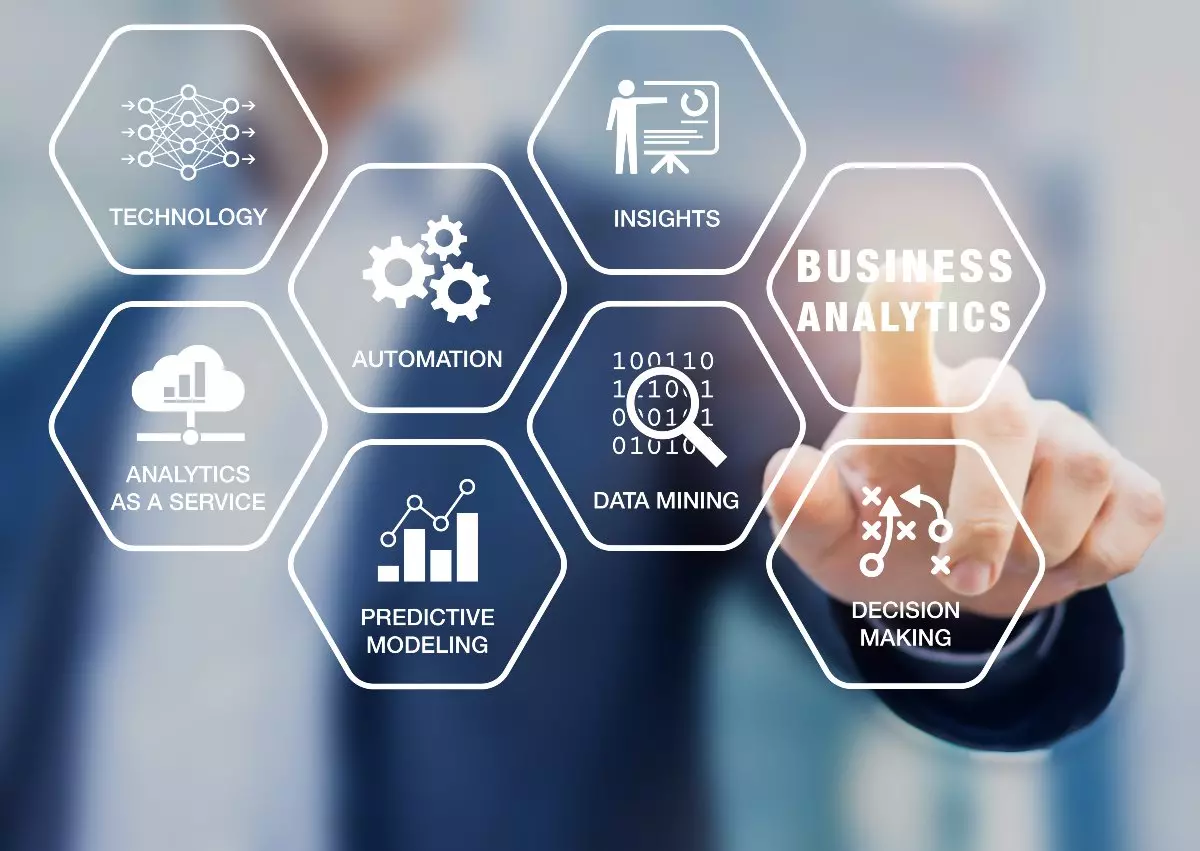Numerous studies show that the big data business intelligence market will grow to $274.3 billion by 2022, with a five-year compound annual growth of 13.2%. Moreover, Forbes predicts that more than 150 zettabytes of real-time data will need analysis by 2025. With the help of big data business intelligence, your company can analyze this influx of data.
As a result, it can help you stay ahead of competitors, design new products, market effectively, improve operational efficiency, and identify new business opportunities. But how does it work? To answer that question, let’s break the term down into two parts: business intelligence and big data analytics.
What is Business Intelligence?

Business intelligence is the process of analyzing a company’s data to produce actionable insights and make educated data-driven decisions. Data relating to sales, marketing, and operations can then be used to optimize company performance. This helps businesses answer their questions, track their performance against these goals, and implement successful strategies.
Starbucks is known worldwide and is one of the largest companies to utilize business intelligence to increase sales. Through business intelligence tools, the company monitors purchase data from loyalty card users. This information is then used to send their consumers’ customized offers, increasing the likelihood that the customer will visit a store and spend.
Business intelligence integrates big data analytics, data mining, data visualization, data infrastructure, data tools, and best practices to help businesses make informed decisions with accurate and actionable information. The graph below explains some of the tools involved in business intelligence:
| Big data analytics | Use of advanced analytic techniques against vast data sets. |
| Data mining | Discovering patterns in large datasets, such as databases and statistics. |
| Data visualization | Communicating data through graphic representation, such as charts and graphs. |
| Data infrastructure | The backend computing support system is required to process, store, maintain, organize, transfer, and safeguard data. |
| Data tools | Software and programs designed to collect, analyze, and present data to help uncover insights. |
| Best practices | Methodologies and techniques proved to produce superior results than those achieved by other means. |
Big Data Analytics
Big data analytics is the process of examining complex datasets to uncover new business information, such as patterns, market trends, and correlations. This helps companies gain insight into their business, make informed decisions, answer operation and performance queries, gain competitive advantages, and improve business-related outcomes.
To reach these insights, the following steps are taken:
- Data scientists collect, process, clean, and analyze data.
- This data is gathered from various sources, including cloud applications, mobile apps, social media, internet clicks, and web server logs
- Data scientists prepare and configure data for analytical queries.
- Professionals look for errors or inconsistencies.
- The data is cleaned to improve its quality using scripting tools.
- Analytics software evaluates the collected, processed, and cleaned data.
Almost every industry can benefit from big data analytics as it helps organizations in customer acquisition and retention, targeted ads, product development, price optimization, and risk management. For example, the healthcare industry can manage patient records and insurance claims more efficiently and improve diagnoses and treatment options through electronic health records. These electronic records include medical diagnoses, prescriptions, and results obtained from various laboratory tests.
What is Data Mining?

Data mining is used interchangeably with data analytics and focuses on finding relevant information for predictive modeling. The process of data mining involves using statistical methods, algorithms, and software to identify patterns in large datasets. This can help answer queries and predict future trends and behavior, such as understanding what products and services are commonly purchased together or identifying fraudulent transactions. It can also set the organization apart from its competitors and offer personalized experiences for customers, such as product suggestions based on previous purchases.
For example, using data mining, companies can improve lead conversion rates in sales, build risk models, detect fraud in finances, manage supply chain operations, and identify quality issues.
Data mining comprises three disciplines:
- Statistics: the numerical study of data relationships
- Artificial Intelligence: computer systems, software, or machines that can perform tasks that require human-like intelligence, such as speech recognition and visual perception
- Machine Learning: the ability of machines to learn from data with minimal human assistance
Data mining is often seen as the precursor to business intelligence. However, data is often raw and unstructured upon collection, making it challenging to analyze. Therefore, data mining decodes these complex datasets before business intelligence can extract insights. In other words, analysts use data mining to collect the information they need and follow up with business intelligence tools to understand the importance of the information.
Data Intelligence vs. Data Analytics
Data intelligence and data analytics may sound similar because they assist in collecting data and analyzing it for future operations. However, there are significant differences between the two.
Data intelligence collects and analyzes data to determine what happened in the past and why. Data analytics uses the same data to predict what will happen in the future. Nonetheless, the two concepts are intertwined so that one cannot operate without the other.
For example, a company has launched a new product. After a few months, the company has quantitative data, such as how many units were sold and who bought them. Additionally, they have qualitative data, such as product reviews and marketing campaigns. In this case, scientists would use data intelligence to determine how and why the launch was successful. Later, analysts would use data analytics to predict future projections and implement strategies to sell more products.
Better Response to Customers

Thanks to big data analytics, companies can better respond to customers and understand their needs. For example, businesses can determine why customers have left and what strategies may attract them to return. Organizations can also understand customer preferences, allowing them to create targeted marketing campaigns. Moreover, big data analytics can forecast customer behavior to improve customer satisfaction and loyalty.
For example, by leveraging business intelligence, American Express identified up to 24% of its Australian users who deactivated their accounts within four months. As a result, the company took the necessary steps to retain its customers better.
Machine Learning-Based Revenue Growth
Machine learning makes it quicker to analyze massive data. A computer can process around two billion operations per second. Thanks to the speed, organizations can analyze large and complex volumes of data to gain real-time trends.
For example, Chipotle Mexican Grill has around 2,788 restaurants worldwide and implements business intelligence to monitor every restaurant’s operational efficiency. The reports from the data help the restaurant save time and grow its revenue.
Loss Prevention
Big data analysis can help companies with loss prevention. Loss prevention aims to reduce preventable theft, vandalism, employee misconduct, fraud, shoplifting, and inventory damage. For example, data analysis can inspect when and where most incidents occur. This information can then be used to develop better security strategies.
Better Pricing

Big data analysis can help businesses identify the ideal prices for their products or services and find the balance between beating the competition and turning a maximum profit. For example, it can examine the costs for an item in the industry and compare the highest sales by processing historical data.
Better Product Innovation
Big data analytics may predict how consumers will react to a product before its development and launch. This is an effective way for businesses to stay ahead of the competition and prevent financial loss in product innovation. Data analytics can also determine customers’ needs, tastes, and preferences and assess what other products they might need.
For example, if a customer has bought white sneakers from an online store, business intelligence can recommend a shoe cleaner as an add-on purchase.
Streamlined Product Roadmaps
If a company has a new product idea that it wants to produce, big data analytics can help avoid trials and errors. Moreover, it can figure out the best manufacturing practices. Finally, big data analytics can ultimately reduce costs. In addition, the technology can help businesses learn from previous competitors’ mistakes and analyze faulty products and materials.
More Efficient Product Configurations
Product configuration is the process of customizing a product to meet a customer’s needs, thanks to the recommendations from AI-based data. With more efficient product configuration, companies can offer the goods that the consumer needs. Moreover, businesses can maximize margins by finding the ideal price point. The company can also build product bundles and create upselling packages for each consumer.
For example, Lowe’s uses business intelligence to collect online offline data that helps to assort their products effectively. The company also uses predictive analytics to dispatch products that are in demand.
Better Order Management

Inventory can also be managed with the help of business intelligence to ensure you aren’t ordering too much or too little. For instance, the technology looks at the number of products the store sold over the last year and whether the sales volumes increased. It can also look at how well a product sells industry-wide to determine the order quantities by uncovering trends, patterns, and correlations.
Reduced Errors
No one is perfect, and even the best employees can make an error that can cost a business time, money, and resources. Such mistakes can also harm customer retention, leading to more money loss. On the bright side, errors can be reduced when using big data analytics. Big data analytics can determine where mistakes occur in your company. This information can address the issues by implementing better business practices. Additionally, business intelligence tools can evaluate other companies with similar problems and compute the best practices based on their errors through periodic competitor analysis.
Improved Upselling and Cross-Selling
Big data analytics can help businesses optimize upselling and cross-selling techniques. For example, data analytics can look at buying patterns and determine which items sell together the most. It can also examine customers’ previous purchases to understand the products the company should advertise to them. This could also help businesses expand their product and service lines to meet consumer demand. Also, as mentioned previously, having a more efficient product configuration can help companies create upselling packages targeted to different types of customers.
For example, Stitch Fix uses business intelligence to understand its consumers’ shopping tastes based on the clothing items they keep and return. This information is then used to offer better recommendations.
More Efficient Advertising

Big data analytics can acquire, process, and analyze data accurately in real-time. Hence, marketers leverage real-time data and stay ahead of the competition due to the reduced time to access insights for efficient advertising. Moreover, data analytics can help businesses perform a brand audit, which is a critical factor for marketing efforts. This is done by automatically gathering analyzing data from the business’s social media pages, marketing analytics, surveys, and web tracking.
Data analytics can pinpoint target customers. For example, it can help you understand which advertising campaigns have performed best and the demographic interested in the company’s products and services. By leveraging data analytics tools, businesses can spend their marketing efforts in cost-effective ways aimed at their ideal customers.
Improved Risk Management
Every business comes with a certain extent of risk that may lower its profits or lead to failure. Unfortunately, it is almost impossible to avoid, which can be an obstacle when a company seeks growth or wants to achieve a new objective. However, big data analytics is a powerful tool for risk management, especially financial risks. It can forecast real-time risks by detecting patterns that indicate a potential threat to your business. For example, companies can use predictive analytics and look at past datasets to help predict and reduce churn in a specific customer segment.
It’s worth noting that no risk assessment platform is perfect, and there will always be mistakes in any model.
Final Thoughts
Companies that incorporate big data business intelligence can identify new opportunities for more innovative business moves. The technology helps companies make real-time informed decisions, stay ahead of the competition, generate revenue, understand customers more effectively, improve risk management, and manufacture new products.
Table of Contents
- What is Business Intelligence?
- Big Data Analytics
- What is Data Mining?
- Data Intelligence vs. Data Analytics
- Better Response to Customers
- Machine Learning-Based Revenue Growth
- Loss Prevention
- Better Pricing
- Better Product Innovation
- Streamlined Product Roadmaps
- More Efficient Product Configurations
- Better Order Management
- Reduced Errors
- Improved Upselling and Cross-Selling
- More Efficient Advertising
- Improved Risk Management
- Final Thoughts
Have a Question? Ask an Expert!
Fill out the form below to get in touch with one of our marketing specialists.
